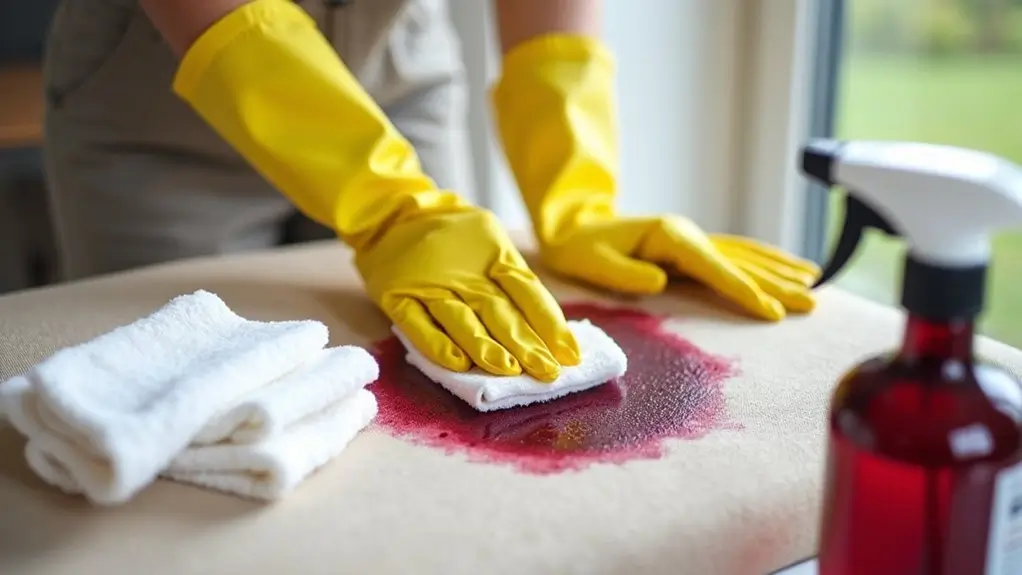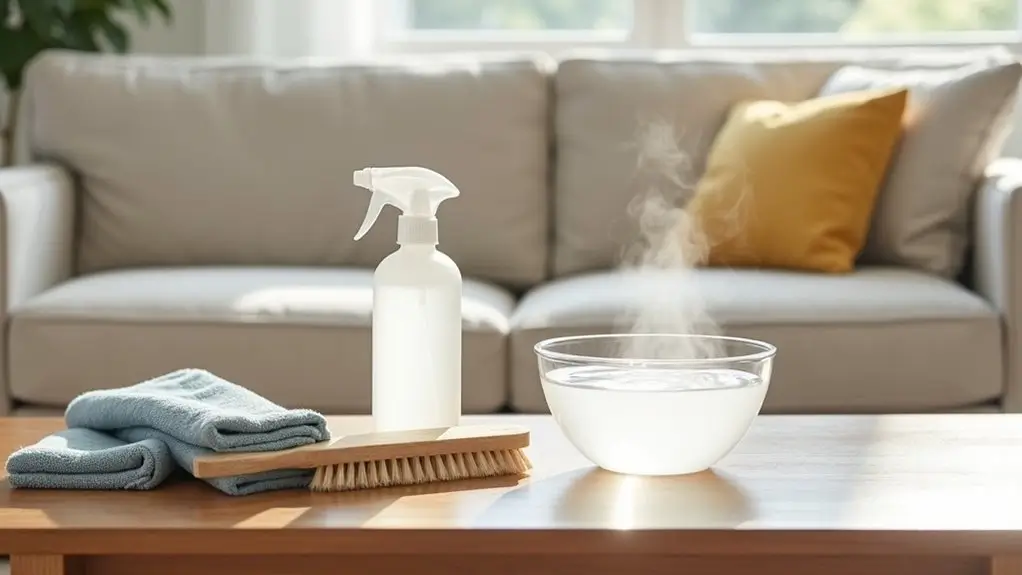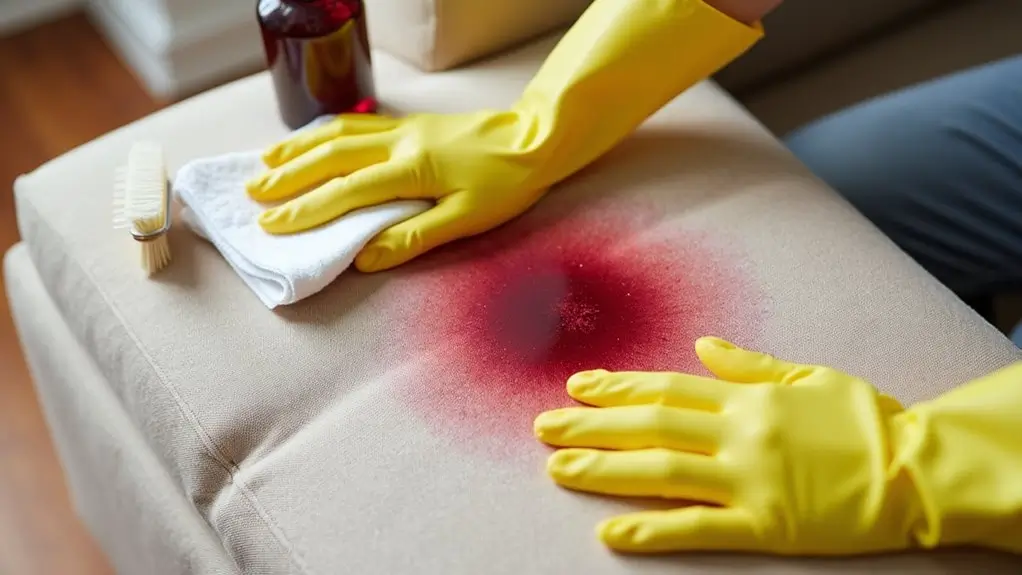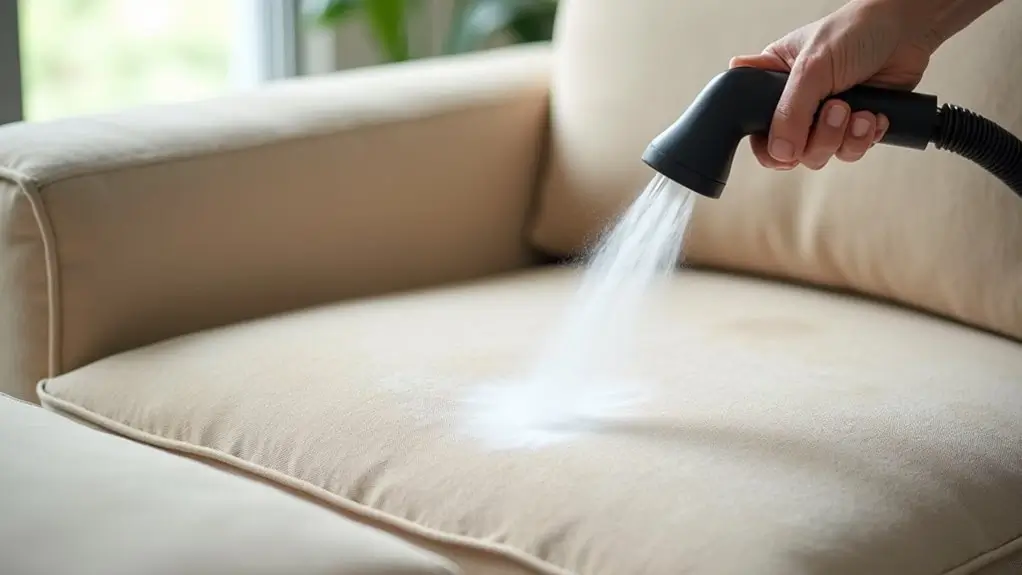You'll find that keeping your upholstery clean isn't just about aesthetics—it's vital for extending your furniture's life and maintaining a healthy home environment. Whether you're dealing with stubborn wine stains, pet accidents, or everyday dirt, the key lies in understanding your fabric's specific needs and applying the right cleaning techniques. Before you tackle that mysterious spot on your favorite sofa, let's explore the essential steps that'll help you clean with confidence and avoid costly mistakes.
Key Takeaways
- Check the upholstery cleaning code (W, S, W/S, or X) on the manufacturer's tag to determine the appropriate cleaning method.
- Vacuum thoroughly with an upholstery attachment to remove loose dirt and debris before applying any cleaning solutions.
- Blot stains from the outer edges toward the center using cleaning solutions suitable for water-based or oil-based stains.
- Test cleaning solutions on an inconspicuous area first and avoid oversaturating the fabric while cleaning.
- Allow furniture to dry completely after cleaning, using fans if necessary, and maintain with regular weekly vacuuming.
Understanding Upholstery Fabric

Before cleaning your upholstered furniture, you'll need to identify both the fabric type (such as cotton, wool, or synthetic blends) and the cleaning code on the manufacturer's tag.
Understanding these codes (W, S, W/S, or X) is essential, as using the wrong cleaning method can permanently damage your furniture.
Once you've determined the fabric type and code, select an appropriate cleaning solution that matches the manufacturer's specifications, whether it's water-based, solvent-based, or specialized upholstery cleaners.
Types of Upholstery Fabric
Different upholstery fabrics require specific cleaning methods to maintain their appearance and durability.
When you're ready to clean upholstery, check the fabric's cleaning code first. Natural fibers like cotton and linen typically allow water-based upholstery cleaners (Code W), while synthetic materials like polyester and nylon often accept both water and solvent-based solutions (Code W/S).
Delicate fabrics such as silk and velvet usually require dry cleaning solvents (Code S) for spot clean treatments. Some materials, marked with Code X, can only be vacuumed.
Always test your cleaning solution in an inconspicuous area before attempting full stain removal.
Importance of Upholstery Codes
Properly interpreting upholstery codes stands as an essential first step in maintaining your furniture's longevity.
You'll find these cleaning codes on your furniture's tag: "W" indicates water-based upholstery cleaners are safe, "S" requires solvent-based products, "W/S" allows both methods, and "X" means vacuum only.
If you can't locate the cleaning code, test both water-based and solvent-based cleaners separately in inconspicuous spots, waiting 24 hours to observe any adverse reactions.
Choosing the Right Upholstery Cleaner
Selecting an appropriate upholstery cleaner requires careful consideration of your fabric's cleaning code and specific material composition.
You'll need to match your cleaner to the manufacturer's guidelines to avoid damaging your furniture during the deep clean process.
- For W-coded fabrics, choose water-based cleaners that won't leave residue or cause discoloration.
- For S-coded materials, select solvent-based solutions specifically designed for stubborn stains.
- For W/S-coded upholstery, you've got flexibility but must always perform a spot test first.
Remember to check the cleaning codes before applying any solution, and make certain your chosen cleaner is appropriate for both routine maintenance and targeted stain removal.
Preparing for Upholstery Cleaning

You'll need to vacuum your upholstered furniture weekly and perform deep cleaning every 6-12 months, depending on usage and visible soiling.
Before starting any cleaning process, gather essential supplies including a vacuum with upholstery attachments, appropriate cleaning solutions based on your fabric's care code, and clean microfiber cloths or sponges.
To maintain your furniture's appearance and extend its lifespan, establish a regular cleaning schedule that includes both routine vacuuming and periodic deep cleaning sessions.
How Often to Clean Upholstered Furniture
Regular maintenance of upholstered furniture requires a structured cleaning schedule based on usage patterns and environmental factors.
To effectively clean your upholstery, establish a routine that includes weekly vacuuming, monthly spot cleaning, and professional deep cleaning every 12-18 months. Understanding how often to clean helps prevent permanent damage and extends furniture life.
- Vacuum weekly to remove surface debris and prevent dust from settling into fibers
- Address spills and remove stains immediately to avoid permanent marking
- Schedule professional deep cleaning annually, or twice yearly for homes with pets and children
This systematic approach guarantees your upholstered furniture maintains its appearance and structural integrity while creating a healthier living environment.
Vacuuming Your Upholstery
Proper vacuuming serves as the critical first step in any upholstery cleaning process. Before starting, attach your vacuum's upholstery tool to effectively remove loose debris and dust from your sofa's surface.
Work methodically from top to bottom, paying special attention to seams, crevices, and corners where particles accumulate.
Remove cushions and vacuum both sides thoroughly, including underneath where dirt often collects.
Don't forget to clean the back and arms of your furniture. If you're dealing with pet hair, use short, quick strokes to loosen stubborn fur before vacuuming.
Gathering Cleaning Supplies
Before starting any upholstery cleaning project, gathering the essential supplies will guarantee efficient and effective results.
Essential Tools:
- Vacuum with upholstery attachments
- Upholstery cleaner matched to fabric code
- Multiple microfiber cloths
Remember to have cleaning solutions ready for both spot tests and full cleaning. Don't forget white cloths for testing colorfastness, a soft-bristled brush for agitation, and a spray bottle for diluting cleaners.
Keep your supplies organized and within reach during the cleaning process.
Stain Removal Techniques

To effectively remove stains from upholstery, you'll need to first identify whether you're dealing with water-based stains like coffee and wine, or oil-based stains such as grease and makeup, as each requires different treatment approaches.
For water-based stains, you can use a mixture of white vinegar and water (1:3 ratio) applied with a clean microfiber cloth, while oil-based stains typically require a specialized solvent-based cleaner or professional dry-cleaning solution.
When treating any stain, you'll want to blot rather than rub, working from the outer edges toward the center to prevent spreading, and always test your cleaning solution on a hidden area first.
Identifying Different Types of Stains
Successfully identifying the type of stain you're dealing with serves as the essential first step in effective stain removal.
Understanding the stain's composition helps you choose the right cleaner and technique, preventing potential discoloration or damage to your upholstery.
- Water-based stains (coffee, wine, pet stains) - These respond well to water-based cleaners and should be blotted immediately with a clean, white cloth.
- Oil-based stains (grease, makeup) - Require specialized solvents and careful spot testing.
- Combination stains (food, mud) - Need a strategic approach using both water-based and solvent cleaners.
Always address stains promptly, as letting them settle makes upholstery cleaning considerably more challenging and reduces the chances of complete removal.
Best Way to Clean Common Stains
When tackling common upholstery stains, your approach must align with both the stain type and your furniture's cleaning code.
For water-based stains like coffee or wine, first blot the stain with a clean microfiber cloth to absorb excess liquid. If your upholstery code permits water-based cleaners, apply a gentle solution and continue blotting—never rubbing.
For oil-based stains, you'll need solvent-based cleaners if your code indicates 'S'. Please wipe from the stain's outer edge inward to prevent spreading.
After treatment, allow the fabric to dry completely before using the furniture. Don't forget to test any detergent in an inconspicuous area first.
Using Vinegar to Clean Upholstery
Natural cleaning solutions offer a safe alternative to commercial products, and vinegar stands out as one of the most effective options for upholstery care.
Mix one part white vinegar with two parts water in a spray bottle to create your cleaning solution. Apply this mixture to your upholstery fabric using a damp cloth, being careful not to oversaturate the material.
- Let the solution sit for a few minutes to break down dirt and stains
- Blot the clean fabric with a fresh, damp cloth to rinse
- Use a dry microfiber cloth to remove excess moisture
For stubborn stains, increase the vinegar concentration, but always test on a hidden area first to prevent fabric damage.
DIY Upholstery Cleaning Solutions

You'll find significant cost savings by creating your own upholstery cleaning solutions using common household ingredients like white vinegar, dish soap, and baking soda.
To deep clean your furniture effectively, you'll need to follow a systematic process of spot testing, gentle agitation with your chosen DIY cleaner, and proper drying techniques.
When using homemade cleaners, you must carefully measure ingredients and avoid oversaturating the fabric, as excess moisture can lead to mold growth or damage the underlying furniture padding.
Homemade Fabric Cleaner Recipes
Creating effective homemade upholstery cleaners requires a precise combination of common household ingredients that can tackle various fabric challenges.
Mix 1/4 cup liquid dish soap with warm water for a gentle stain remover that's safe on most fabrics. For tougher spots, combine equal parts white vinegar and water to clean the fabric without harsh chemicals.
- Basic Solution: 1/4 cup dish soap + 1 cup warm water, whisk until foamy
- Deep Cleaner: 1/2 cup vinegar + 1/2 cup water + 1 tablespoon dish soap
- Deodorizing Mix: 2 cups warm water + 1/2 cup baking soda + 1 tablespoon vinegar
Always use a clean cloth to absorb excess moisture and test in an inconspicuous area first.
Step-by-Step Guide to Deep Clean Upholstery
With your homemade cleaning solutions ready, proper deep cleaning of upholstery requires a systematic approach to guarantee thorough results.
Begin by checking your furniture's cleaning codes, then vacuum thoroughly using an upholstery attachment to remove loose debris.
Apply your chosen upholstery cleaner to a hidden area first to test fabric care compatibility.
Working from top to bottom, use a soft brush to work the solution into the fabric, being careful not to oversaturate.
Extract the cleaner using a deep clean machine or blot with clean microfiber cloths.
Allow furniture to dry completely before use, using fans to speed the process.
Precautions When Using DIY Cleaners
While DIY cleaning solutions offer cost-effective alternatives to commercial products, they require careful handling to prevent damage to your upholstery.
Before applying any homemade fabric cleaner, check your furniture's upholstery codes and always perform a spot test in an inconspicuous area.
- Never mix cleaning solutions without proper research - combining the wrong ingredients can damage fibers or create harmful fumes.
- Don't saturate your furniture - excess moisture can lead to mold growth and fabric deterioration.
- Always vacuum thoroughly before applying any cleaning solution, and verify surfaces air dry completely.
Remember to maintain proper ventilation and keep cleaning mixtures away from children and pets.
Maintaining Clean Upholstery

You'll need to establish a consistent maintenance routine that includes weekly vacuuming, prompt stain treatment, and seasonal deep cleaning to preserve your upholstery's appearance and extend its lifespan.
When stubborn stains persist or you notice significant wear despite regular care, it's time to contact a professional upholstery cleaner who's specialized equipment and expertise.
Understanding proper upholstery care techniques, including fabric-specific cleaning methods and preventive measures like protective covers, will help you maintain your furniture's beauty while avoiding costly damage or premature replacement.
Regular Maintenance Tips
Three essential maintenance habits will keep your upholstered furniture looking fresh between deep cleanings.
Regular maintenance prevents costly damage and extends your furniture's lifespan, while protecting your investment.
- Vacuum weekly using an upholstery attachment, paying special attention to crevices where debris collects. Don't forget to rotate cushions for even wear.
- Address stains immediately with appropriate cleaning solutions based on your upholstery code.
- Schedule quarterly inspections to check for wear patterns, loose threads, or developing issues.
This proactive approach helps you catch problems before they become serious repairs.
When to Call a Professional Upholstery Cleaner
Professional upholstery cleaning becomes essential when facing specific challenges that exceed the scope of regular maintenance.
Consider hiring a professional if you're dealing with fabrics marked with code "S" or "X" on the manufacturer instructions, as these require specialized cleaning solutions and expertise. You'll also want professional help when encountering extensive stains, water damage, or persistent odors that haven't responded to spot tests.
Don't risk damaging fabric by attempting complex cleaning procedures yourself.
Professional cleaning services offer specialized equipment, appropriate solvents, and expert knowledge of different upholstery materials, ensuring your furniture receives proper care without compromising its integrity or appearance.
Final Thoughts on Upholstery Care
While professional services play an essential role in upholstery maintenance, long-term care relies on consistent preventive measures and proper cleaning habits. Following proper cleaning frequency guidelines and understanding your upholstery code will greatly extend your furniture's lifespan.
- You'll protect your investment by vacuuming weekly and addressing spills immediately with appropriate stain removers.
- You'll preserve fabric integrity by following manufacturer guidelines and using steam cleaners correctly.
- You'll maximize furniture longevity by alternating between routine home care and professional cleaning services.
Remember to document your cleaning schedule and maintain records of professional services to guarantee ideal care of your upholstered pieces.
Frequently Asked Questions
Can I Use Bleach to Clean Light-Colored Upholstery?
Don't use bleach on upholstery, as it'll damage fibers and void warranties. Instead, you should use manufacturer-approved cleaners based on your furniture's cleaning code (W, S, or W/S) for safe and effective results.
How Long Should I Wait Before Sitting on Newly Cleaned Furniture?
You'll need to wait 4-8 hours for water-based cleaning and 24-48 hours for solvent-based solutions. Don't sit on damp furniture, as it can cause mildew. Use fans to speed up drying time.
What's the Best Way to Remove Pet Odors From Upholstery Fabric?
Vacuum thoroughly, then sprinkle baking soda generously and let it sit overnight. You'll need to use an enzymatic cleaner specifically designed for pet odors, followed by steam cleaning for deep-seated smells.
Are There Specific Cleaners for Leather-Trimmed Upholstered Furniture?
You'll need dual cleaners: a leather-specific conditioner for trim and an upholstery cleaner matching your fabric's code. Don't let solutions cross-contaminate, and always test both products in inconspicuous areas first.
How Do I Prevent Water Rings When Spot Cleaning Upholstery?
To prevent water rings, you'll need to feather your cleaning edges by working from the outside toward the center, using minimal moisture and a hair dryer to verify even drying across the entire area.
Conclusion
To maintain your upholstery's ideal condition, you'll need to implement both preventive and reactive cleaning strategies. Always reference your fabric's cleaning code, test solutions beforehand, and address stains immediately using appropriate techniques. Establish a consistent maintenance schedule: weekly vacuuming, monthly spot cleaning, and biannual deep cleaning. When properly executed, these technical procedures will extend your upholstery's lifespan and preserve its aesthetic quality.


0 comments